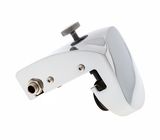I'm not too much into Yamaha gear, but after a good deal of comparison research I bought these for hybrid drumming experiments as the best choice for my needs
I waited a long time to review them to get to use them in different setups..
First: the looks:
Just a work of art.
The chroming is very high quality. Stick hits don't affect the finish.
It's what makes these look good together with the design, and it's what makes this blend in really well on an acoustic drum kit.
Like it belongs there.
It doesn't scream "trigger!" like some others.
Personally I like it. The chrome blend in with the drumset chrome.
Even the tightening screw is from the same kind of metal design like those found in some snare drums with internal dampening.
The mounting:
This screws on every normal drum kettle.
I tried them on standard steel hoops and die-cast versions, didn't notice any difference.
I haven't used this on wood hoops yet, so I don't know if this would scratch up the surface.
I was weary because of the many reviews (also from the better known YT influencers) experiencing the tightening screw shaking loose during sessions.
I never noticed that in any home, rehearsal or live situation.
When I attach it, it feels confident and it just stays there.
It's also quite heavy, which is due to all that metal and chroming.
The triggering:
Nothing else matters about a trigger when... the triggering sucks.
Well it doesn't.
It's a Yamaha brand, and that usually means they don't bring out crap.
I use this on a 13" Tama Club Jam Vintage snare with still the stock Tama skin, upgraded with a die-cast hoop on the batter side.
The trigger is mounted between 11 and 12 'o clock, and triggered with a TRS cable to an Alesis Strike multipad using trig. output 2/3.
2 is for the head, 3 is for the rim.
Snare and rim trigger devices are almost never perfectly seperated for your playing right out of the box.
It depends on your way of playing, the type of snare, hoop, skin..
But I found it useful to set the trigger treshold for both head & rim between 15-20 to not have them interfere each other too much.
But in some cases you'll need another solution when you're going to play fast notes.
That also depends on the sound/sample you'll use.
Some sounds still play fast with a higher trig treshold setting, some don't.
But the interference between rim and head increases with a lower trig treshold...so that will be every players personal tweaking to find a workable solution.
There are many factors to reckon with and you will have to tweak a lot before you have a road ready set up.
No matter the "out-of-the-box" promises from any manufacturer.
But now I'm talking about advanced multi zone triggering here.
Triggering doesn't make much difference with 7a or 5a sticks.
Heavier sticks do tend to trigger a little easier, the way I hit.
Just use the sticks you always use while setting up.
The rim trigger is very sensitive. Even more sensitive than the skin trigger.
So they both need their own approach, again: because everybody plays differently.
It triggers as well as a Roland MicS, which is also a very good trigger, but sadly only standalone.
The sound- and fx possibilities are only limited by your imagination.
Together with a kick trigger one can seriously thicken acoustic sounds with..anything, and turn even a simple drumkit into a monster.
The trigger keeps up with fast strokes, but as I mentioned, if you really are going to usurp all the multizone possibilities of your sound module, you are going to have a sweet time tweaking your trigger settings to make that happen flawless and reliable...with any trigger.
Don't forget to save your setting every time after a succesfully tweak.
Don't wait till you're finished...it's still computers you're working with and you know how computers sometimes will have their...hic ups.
I will also add that the level meters on the Alesis Strike Multipad help me a lot when calibrating multizone trigger set ups. Sometimes it's just easier to see than to hear a loud rimshot triggering a soft headshot, or vice versa.
If your module hasn't got that option, there's always the level LED's of a mixer.
I also find it useful for a faster workflow to seperate/route your to-be-tweaked sounds to an AUX.
That way it will be even easier to see what the sounds "do', especially if you have seperated MAIN and AUX level meters.
Sometimes the meters tell another story than your ears, and you will find that out when testing your set up in different surroundings.
.

